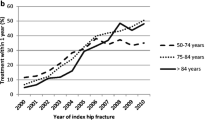Abstract.
Objective: Osteoporosis and its complications represent one of the most important causes of morbidity and mortality among the elderly. Despite the availability of several drugs deemed effective at reducing the incidence of fractures, only a minority of patients receive pharmacological treatment. We studied patients with a diagnosis of osteoporosis at discharge from hospital in Italy to identify predictors of receiving specific pharmacological treatment and to analyse how the pattern of drug prescription has changed in the last decade. Methods: We analysed data from a multicentre pharmacoepidemiology study that collected data on hospitalised patients throughout Italy. Patients with a diagnosis of osteoporosis admitted during five different surveys in 1988, 1991, 1993, 1995 and 1997 were considered for the present study. Results: Of 863 patients with a diagnosis of osteoporosis, 461 (53.4%) received treatment. Age [odds ratio (OR) 0.86 for each decade of increment, 95% confidence interval (CI) 0.73, 0.99], male gender (OR 0.67, 95% CI 0.44, 0.99), number of comorbid conditions (4–5 vs 0–3 conditions: OR 0.66, 95% CI 0.47, 0.91; 6 or more vs 0–3 conditions: OR 0.47, 95% CI 0.31, 0.72) and number of medications (OR 0.92 for each drug increase, 95% CI 0.85, 0.99) were all associated with a reduced likelihood of receiving pharmacological treatment for osteoporosis. In contrast, concomitant corticosteroid use (OR 2.00, 95% CI 1.05, 3.80), admission for hip or vertebral fracture (OR 2.10, 95% CI 1.12, 3.93) and year of survey (OR 1.11, 95% CI 1.01, 1.24) were independent predictors of a higher treatment rate. Among individual drugs, calcitonin use remarkably declined from 42.1% in 1988 to 0.8% in 1997 (P for trend <0.001), while bisphosphonate prescriptions increased from 1.3% in 1988 to 34.9% in 1997 (P for trend <0.001). Prescription of calcium did not change significantly throughout the decade examined, while vitamin D had a twofold increase (14.2% in 1988 to 26.2% in 1997, P for trend <0.001). Conclusions: Among patients discharged from hospital in Italy, osteoporosis is an uncommon diagnosis. Even when the diagnosis is made, osteoporosis is often under-treated, and treatment is reserved for younger and less medically complex patients.
Similar content being viewed by others
Author information
Authors and Affiliations
Additional information
Accepted in revised form: 12 July 2001
Electronic Publication
Rights and permissions
About this article
Cite this article
Onder, G., Pedone, C., Gambassi, G. et al. Treatment of osteoporosis among older adults discharged from hospital in Italy. Eur J Clin Pharmacol 57, 599–604 (2001). https://doi.org/10.1007/s002280100370
Received:
Issue Date:
DOI: https://doi.org/10.1007/s002280100370




